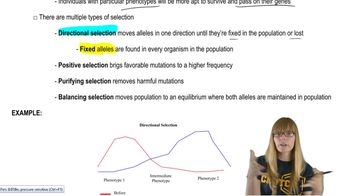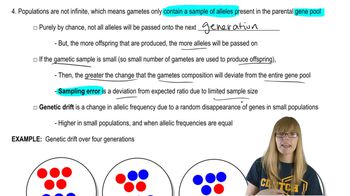Table of contents
- 1. Introduction to Genetics51m
- 2. Mendel's Laws of Inheritance3h 37m
- 3. Extensions to Mendelian Inheritance2h 41m
- 4. Genetic Mapping and Linkage2h 28m
- 5. Genetics of Bacteria and Viruses1h 21m
- 6. Chromosomal Variation1h 48m
- 7. DNA and Chromosome Structure56m
- 8. DNA Replication1h 10m
- 9. Mitosis and Meiosis1h 34m
- 10. Transcription1h 0m
- 11. Translation58m
- 12. Gene Regulation in Prokaryotes1h 19m
- 13. Gene Regulation in Eukaryotes44m
- 14. Genetic Control of Development44m
- 15. Genomes and Genomics1h 50m
- 16. Transposable Elements47m
- 17. Mutation, Repair, and Recombination1h 6m
- 18. Molecular Genetic Tools19m
- 19. Cancer Genetics29m
- 20. Quantitative Genetics1h 26m
- 21. Population Genetics50m
- 22. Evolutionary Genetics29m
21. Population Genetics
Allelic Frequency Changes
Problem 9b
Textbook Question
Textbook QuestionIf 4 percent of a population in equilibrium expresses a recessive trait, what is the probability that the offspring of two individuals who do not express the trait will express it?
 Verified Solution
Verified SolutionThis video solution was recommended by our tutors as helpful for the problem above
Video duration:
1mPlay a video:
Was this helpful?
Key Concepts
Here are the essential concepts you must grasp in order to answer the question correctly.
Hardy-Weinberg Equilibrium
The Hardy-Weinberg Equilibrium is a principle that describes the genetic variation in a population that is not evolving. It provides a mathematical model to predict allele frequencies and genotype frequencies in a population under certain conditions, such as no mutation, migration, or selection. This concept is essential for understanding how traits are distributed in a population and serves as a baseline for studying genetic changes.
Recommended video:
Guided course

Hardy Weinberg
Recessive Trait
A recessive trait is a phenotype that only manifests when an individual has two copies of the recessive allele. In the context of genetics, if a trait is recessive, it can be masked by a dominant allele. Understanding how recessive traits are inherited is crucial for predicting the likelihood of offspring expressing these traits, especially when considering the genotypes of the parents.
Recommended video:
Guided course

Traits and Variance
Punnett Square
A Punnett Square is a diagram used to predict the genotypes of offspring from a cross between two individuals. It allows for the visualization of how alleles combine during reproduction, helping to determine the probability of inheriting specific traits. In this scenario, using a Punnett Square can clarify the likelihood that offspring of two non-expressing individuals will express a recessive trait, given the allele frequencies in the population.
Recommended video:
Guided course

Chi Square Analysis

 5:58m
5:58mWatch next
Master Natural Selection with a bite sized video explanation from Kylia Goodner
Start learning




